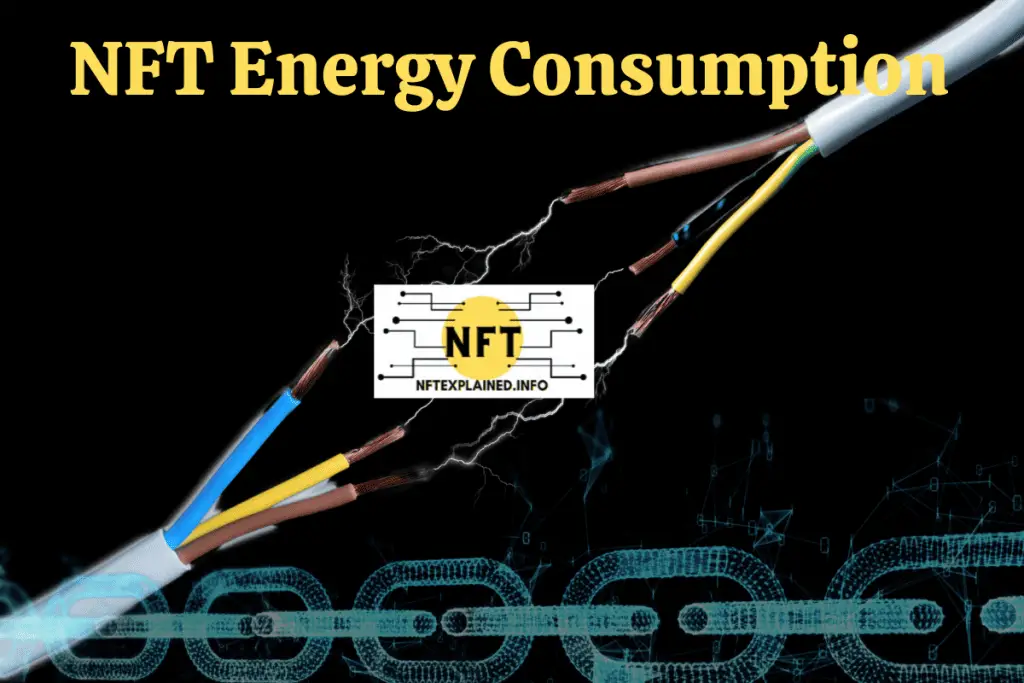
When discussing NFTs, a common concern I hear regarding the drawbacks of this emerging technology is its energy consumption. While this concern may hold some validity in certain cases, it is essential to recognize what actually causes high NFT energy consumption.
NFTs themselves don’t consume much energy; it’s the underlying blockchain that causes energy consumption due to miners verifying NFT-based transactions. NFT energy consumption varies based on the blockchain consensus algorithm the NFT is created on – with Proof of Stake using less energy than Proof of Work.
When discussing the perceived high energy consumption of NFTs, it’s crucial to distinguish that the NFTs themselves are not the primary source of this energy usage.
Instead, it is attributed to a particular blockchain algorithm, where miners compete to verify transactions including the transaction that identifies the owner of an NFT. This model, where miners compete amongst one another, is known as Proof of Work (PoW), and is notorious for its energy intensity.
In the subsequent sections, I will delve into detailed explanations of both Proof of Work and Proof of Stake (PoS) to shed light on why some people associate NFTs with high energy consumption.
To gain a better understanding, let’s first focus on Ethereum-based NFTs since the Ethereum blockchain is where the vast majority of NFTs are created and traded.
Ethereum-Based NFT Energy Consumption: Explained
NFTs based on the Ethereum blockchain consume an estimated 0.0000936 – 0.0028600 kWh per transaction (based on high throughput estimation). This energy consumption is comparable to the traditional centralized payment system VisaNet. Ethereum currently is the most popular blockchain for NFTs.
I was able to find the exact kWh per Ethereum-based transaction from UCL’s research paper which can be downloaded from their site linked here. Furthermore, you can read this article, which analyzes their findings; I recommend reading that article because it explains their findings in a readily comprehensible fashion.
The perception of high energy consumption associated with NFTs stems from Ethereum’s previous use of the Proof of Work consensus algorithm. However, Ethereum underwent a significant transition in September 2022 by adopting the Proof of Stake algorithm.
This switch resulted in approximately a 30,000% increase in energy savings for the same blockchain. The move to PoS marked a substantial improvement in energy efficiency such that any given transaction is now comparable to Visa (credit card) transactions.
Despite the reputation surrounding NFTs and their energy consumption, I think it’s worth noting that there are carbon-neutral blockchains available. Moreover, several blockchains operate with energy consumption that is even lower than that of a Visa transaction.
To gain a comprehensive understanding of the perception regarding NFTs and their energy consumption, it is essential to delve into the intricacies of the Proof of Work algorithm.
Examining Why NFT Energy Consumption Varies Greatly
NFTs on Proof of Work blockchains consume significant energy as miners compete to verify transactions, with only one succeeding while all other miners consume energy in vain. In contrast, Proof of Stake NFTs use energy comparable to traditional financial processing systems as only one miner is chosen to verify the transaction.
When transacting on the blockchain, you’ll encounter gas fees, which serve as compensation for miners verifying transactions. All blockchain transactions incur gas fees including the minting or transferring of an NFT.
These fees reward miners for the energy expended to ensure transaction validity and uphold blockchain security. As a blockchain user, you become accustomed to these gas fees, which contribute to maintaining the overall integrity of the blockchain network.
To further understand this I’ll explain how each model works and examine the intricacies that make PoW and PoS differ dramatically in terms of energy consumption.
Exploring Proof of Work: A Key Consensus Algorithm Explained
Before I dive into PoW and then PoS in the following section, it’s important to note that these are the two prevailing blockchain consensus algorithms used. While there may be minor variations in the implementation of PoW or PoS across different blockchain networks, the fundamental principles remain consistent.
Proof of Work is a blockchain consensus algorithm that relies on miners or powerful computers to solve complex puzzles to validate transactions. The miner who solves the puzzle fastest receives the “gas fee” or reward, while other miners who couldn’t verify the transaction in time receive no reward.
The Proof of Work consensus algorithm has a significant drawback in terms of its energy consumption during the mining process. With the growing demand for Bitcoin, a cryptocurrency built on PoW, there is a rising competition among increasingly powerful computers.
The rising competition of many miners from all over the world make the Bitcoin blockchain extremely safe but energy intensive. In addition to solving complex puzzles there is a racing aspect to the algorithm which incentivizes higher transaction processing power.
As more miners join, expensive and faster processing power becomes necessary to stay competitive. Think about a Prius competing against Corvettes and Lamborghinis; the Prius would never win. In this analogy, the Prius is comparable to a computer with low processing power.
Apart from the energy consumption associated with the Proof of Work (PoW) consensus algorithm, there are notable advantages that contribute to its security.
The first is Network Decentralization. For a transaction to be manipulated, an attacker would need to control 50% of the network’s computational power. However, since PoW is performed by computers worldwide, it becomes impractical for a single entity to attain such control. This decentralized nature enhances the security of the network, as no single entity can dominate the consensus process.
The second is the Longest Chain Rule. Each computer participating in PoW maintains the record of the longest chain of blocks. This rule makes it extremely challenging for an attacker to catch up with the existing chain and surpass its length. As more blocks are added, the difficulty increases, providing additional protection against transaction manipulation and ensuring the integrity of the blockchain.
The third is the Computational Difficulty. The puzzles involved in validating transactions through PoW are deliberately designed to be time-consuming and computationally demanding to solve. The high level of difficulty acts as a deterrent against attempts to add blocks faster than the existing longest chain. It would require a substantial amount of computational power to accomplish such a feat, making it impractical and resource-intensive for attackers.
The continued usage of the PoW consensus algorithm by certain blockchains can be attributed to the advantages it offers in terms of security. If the level of security provided by both PoW and PoS algorithms were equal, I am one hundred percent certain all blockchains would use PoS.
The debate surrounding the choice between PoW and PoS algorithms is and has been ongoing, with economists and mathematicians debating which one is better. It is a complex discussion and I believe it is crucial to have a comprehensive understanding of both algorithms and their respective implications before deciding which one is better for you to use.
While I’ve provided a brief explanation of how PoW operates, I have only touched the surface; however, a more thorough explanation is beyond the scope of this article. With that, let’s examine PoS.
Understanding Proof of Stake: A Comprehensive Guide to the Consensus Algorithm
With a single validator chosen, Proof of Stake offers an environmentally friendly approach as there is reduced resource consumption.
Proof of Stake (PoS) is a consensus algorithm where a single validator, who is staking the blockchains’ native cryptocurrency, is chosen to verify a transaction for a reward. Other stakeholders also confirm the transaction and therefore are rewarded. If a stakeholder acts dishonestly they lose their staked assets.
To become a validator, a predetermined amount of the native cryptocurrency must be pledged, ensuring accountability. This requirement acts as a deterrent against fraudulent activities, as validators who verify false transactions will have their collateral slashed.
In the majority of PoS algorithms, a single miner is selected as a validator based on the magnitude of their pledged collateral. The greater the pledged amount, the higher the likelihood of being chosen to validate a transaction.
After the selected miner verifies a new transaction, other eligible participants in the validator pool also validate its legitimacy and typically receive rewards. However, these rewards are usually smaller compared to the reward received by the miner who verified the initial transaction.
Again, this consensus algorithm works by having the validator receive the gas fee, which is the reward paid for by the person who is attempting to have their transaction validated. The gas fee could be paid in order to have their NFT minted.
The reason the energy difference is so severe between PoW and PoS is because one single miner is selected by the algorithm in PoS. Unlike Proof of Work, there is no competition among many miners to solve or encrypt blocks within the blockchain.
Discover the Price of Minting an NFT: Unveiling the Cost Factors
The cost to mint an NFT depends on two factors: the creator’s set mint price in the smart contract and the gas fee paid to miners for verifying the transaction. These factors vary significantly; typically, mint price is based on the artist’s reputation and the gas fee is based on transaction volume at that time.
To further illustrate this point, I have minted NFTs for free while I have paid hundreds of dollars to mint others. The mint price typically varies based on numerous factors including demand.
With regards to gas fees, both the PoW and PoS blockchain are very comparable and I have not noticed a significant difference thus far. I have paid as little as $2 in gas fees and as much as $200 during times where there was high demand for transactions (i.e. the minting of a NFT collection that is extremely sought-after).
Overall, I think the NFT space is becoming more green as the majority of NFTs are traded on PoS blockchains like Ethreum and Solana. Additionally, OpenSea, the largest NFT marketplace utilizes “lazy minting” which means the NFT is not minted – which causes no blockchain transaction – until someone purchases the item.
This allows digital creators to showcase their work without incurring the gas fee and the energy consumed from making a blockchain-based transaction.
I hope you found this article informative and continue to stay informed with NFT Explained. You can find us on YouTube, Instagram, Twitter & TikTok.
If you found value in our content or wish to support our educational mission, you can collaborate with our partners by utilizing the affiliate link – through purchasing a Ledger hardware wallet!
